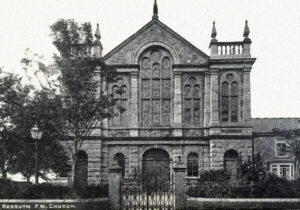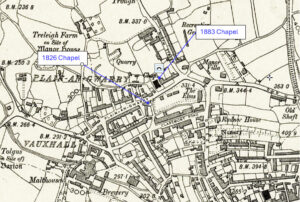This profile of Redrith Primitive Methodist Chapel has been compiled by Jo Lewis and tony Mansell.
In 1825 William Turner of the Redruth (Treruffe Hill – MM link?) Bible Christian Chapel invited William Clowes to Redruth. Willam Clowes was a Primitive Methodist missionary, strongly linked to Hugh Bourne (the founder of the PM Connexion). From this visit, Primitive Methodism was established in Cornwall. Mr Clowes was the first Primitive Methodist Missionary to Cornwall. His labours were chiefly confined to Redruth and the vicinity; he paid a few visits to St Austell and a few neighbouring places, but his head-quarters were at Redruth where he laid the foundation of a revival which broke out just after he had left the country.
He was succeeded by Messrs. John Gamer, W. Driffield, Richard Abey, and John Hewson (see below)
The History of the Primitive Methodist Connexion from its origin (John Petty, 1860) notes accounts from Willam Clowes: On Monday, February 24th, 1826, I attended our preparatory Quarterly Meeting at Redruth, when the number of members in the mission was reported to be 235; and our financial affairs were good; so that we received nothing from Hull Circuit’s funds, either for salaries or for travelling expenses.”
However, he could not remain in Cornwall and in September 1826 he was succeeded by John Garner who became the Superintendent of the Cornish Mission.
In the month of March 1827 (following the opening of the chapel – see below) a great revival broke out at Redruth and in the neighbourhood, and thence extended itself to St. Austell and other places. ”Frequently no less than twenty persons joined our society in an evening,” says Mr Gamer: “and during the ten months I have been at Redruth, more than six hundred have united with the Primitive Methodist Connexion in Cornwall.”
1826 Primitive Methodist Chapel
Located in Plain-an-Gwarry. From Kings Street, turn into Chapel Row and the old chapel is on the right and can also be seen from the main road.
1826: Built as a Primitive Methodist chapel. (SWChurches)
The first Primitive chapel was built here in 1826, following Hugh Bourne’s (probably an error as it was William Clowes) visit and taking over of a previously unaffiliated class group under William Turner (Bible Christian minister).
The first minister was William Driffield and a revival immediately broke out (as above). It is told that one day they were praising God so much the floor gave way but no one was injured. They were known locally as “the ranters”.
Driffield later left to become minister of the Fore Street St Ives Primitive chapel.
There are various documents of leasing, conveyance and mortgage in Driffield’s name (1827 -1828) for the chapel. Correspondence (1845 to 1850) suggests this became a problem. A book entitled ‘The Redruth Chapel Case’ includes copies of original correspondence and other documents relating to difficulties with ownership of the building. William Driffield had taken out the mortgage on the chapel, and now the executors of the mortgagor, Mr Mitchell, deceased, wished the debt repaid or they would sell the chapel. Agreement was eventually reached and the society purchased its chapel.
Heritage Gateway: Original Plain-an Gwarry Primitive Methodist chapel, built 1827. Later in 1882 it became the Sunday school to the new chapel across the road. Later converted to an activity centre. Formerly there were three slate tablets with the Lord’s Prayer, creed and decalogue , cut by Amos Nicholls, in 1827 located at the east end-these have been removed to the Wesleyan Memorial Institute adjacent to the Wesleyan chapel in the centre of Redruth.https://www.heritagegateway.org.uk/Gateway/Results_Single.aspx?uid=MCO33133&resourceID=1020
1827: The first Sunday school was built on the same site.
1851 return notes: Plain An Gwarry, Primitive, Redruth, 1826 for 700 persons, with John Richards (minister).
1852: The Primitive Methodist magazine for August 1852 contains an account by G Price (George Price was the minster at this time) of the re-opening of the chapel.
1852: It was transferred to the Primitive Methodist Connexion (assignment in trust 1852 document exists). At the same time it was thoroughly renovated with many improvements including a good batten floor, a singing gallery and bringing the pulpit forward. The cost of the legal and renovation work was around £300 of which they had raised £85. The re-opening took place on Sunday June 20th when Mr Sharp of Penryn, Mr Allington of Tavistock and Mrs Giles of St Day were the preachers. At the tea meeting on the following Thursday over 400 people were fed.
1883: When the second chapel was built this building became the Sunday School and then an activity centre.
The chapel was later used as a rehearsal rooms for the local town Operatic society, however much of the old fabric remains and the balcony and class rooms can still be seen.
Further reading:
https://ukwells.org/wells/redruth-primitive-methodists
1883 Primitive Methodist Chapel

Located in Plain-an-Gwarry almost opposite the first chapel, on the main road, at the junction with Pond Lane.
1883/84: Built to replace the 1826 chapel, the chapel is an edifice in a Classic style, designed by James Hicks.
1882: Redruth Primitives about to build a new chapel. (Cornishman – Thursday 15 June 1882)
The 1882 Primitive Methodist magazine contains an account of the laying of the foundation stones for a new Primitive Methodist chapel at Redruth. They had wanted a new chapel for some time but could not find a suitable site. However, the account tells us they had found a site near the old chapel and were starting work.
The new chapel was expected to cost around £3,000 of which they had raised £2,000. Unusually for a Primitive Methodist chapel, they hoped it would be debt free at the time of opening.
Documents exist for conveyance and lease of plot (1882).
With seating for 800 persons, it was known as the Cathedral of Primitive Methodism.
Heritage Gateway: Large Primitive Methodist chapel by James Hicks of Redruth, built in 1883, now disused and with consent to demolish prior to redevelopment of the site for houses. Built to replace the 1826 chapel nearby. During its building, three workmen were killed when the scaffolding collapsed while they were positioning a granite block 30 feet above the ground (1).
Dressed granite front with elaborate detail; dry slate roof with decorative banding. Rich eclectic mix of Italianate and Gothic styles. Impressive 2-storey show front has 3-bay pedimented centre and flanking projecting stair and entrance towers. Central bay has large 3-light traceried window that rises into the pediment. Flanking 2-light traceried windows similar to tower windows, all framed by Tuscan pilasters, the towers surmounted by balustraded parapets with end finials. Ground floor has central wide elliptically-arched doorway flanked by round-arched windows with fanlight heads. Towers have round-arched doorways. All original glazing, most with coloured leaded glass; original panelled doors with chamfered detail. Original galleried interior with original fittings (not inspected). Low forecourt walls and tall dressed granite gate-piers with moulded pyramidal caps.
This is by far the most ornate example of a Primitive Methodist chapel in Cornwall and the dominant building in the Conservation Area of Plain-an-Gwarry. https://www.heritagegateway.org.uk/Gateway/Results_Single.aspx?uid=MCO33134&resourceID=1020
Listing: Dressed granite front with elaborate detail; dry slate roof with decorative banding. Rich eclectic mix of Italianate and Gothic styles. Impressive 2-storey show front has 3-bay pedimented centre and flanking projecting stair and entrance towers. Central bay has large 3-light traceried window that rises into the pediment. Flanking 2-light traceried windows similar to tower windows, all framed by Tuscan pilasters, the towers surmounted by balustraded parapets with end finials. Ground floor has central wide elliptically-arched doorway flanked by round-arched windows with fanlight heads. Towers have round-arched doorways. All original glazing, most with coloured leaded glass; original panelled doors with chamfered detail. Original galleried interior with original fittings (not inspected). Low forecourt walls and tall dressed granite gate-piers with moulded pyramidal caps.
1889: A new organ. (The Cornish Telegraph – Thursday 26 September 1889)
1889: A few years ago the Redruth Primitives built a new chapel. (Cornubian and Redruth Times – Friday 27 September 1889)
1932: The Wesleyan, Primitive Methodist and the United Methodist Church amalgamated to become the Methodist Church of Great Britain.
1932: Became Plain-an-Gwarry Methodist Church.
1940: Seating for 800. (Revd David Easton)
1968: Closed. (other references: 1975 – Revd David Easton / SWChurches) when the town Methodist churches all combined to make the Redruth Methodist Chapel near the railway station (Wesley Complex).
Initially there were plans to demolish the building top make way for housing but it was converted into flats, with the exterior retained.
It is a grade 2 listed building.
Further reading:
Redruth Primitive hymn tune: https://cornishnationalmusicarchive.co.uk/content/redruth-primitive-hymn-tune-by-r-t-beer/
https://www.myprimitivemethodists.org.uk/content/chapels/cornwall/redruth-primitive-methodist-chapel
https://kresenkernow.org/SOAP/search/Redruth%20Primitive/

 Map:
Map: